Use this arrow to see more about each stop.
Calling All Recruits!
Fort Scott National Historic Site is inviting you on a quest through history and the chance to earn your own Junior Ranger badge!
Your mission:
Travel to 10 of the sites along the Kansas-Missouri border listed on this page. (See a full map at the button below.) At each one, post an image of your adventure on Instagram. Caption your photo with a sentence describing the site's significance to local history and hashtag it with #FrontierQuestFOSC and #FortScottNPS.
MAPOnce you have made 10 posts, head to Fort Scott National Historic Site and verify your journey with the Ranger on duty to receive your badge.
Scroll right to see the map. Scroll down to begin the tour.
Previous slide
Next slide
Bates County Museum
802 Elks Dr. Butler, MO
DIRECTIONS802 Elks Dr. Butler, MO
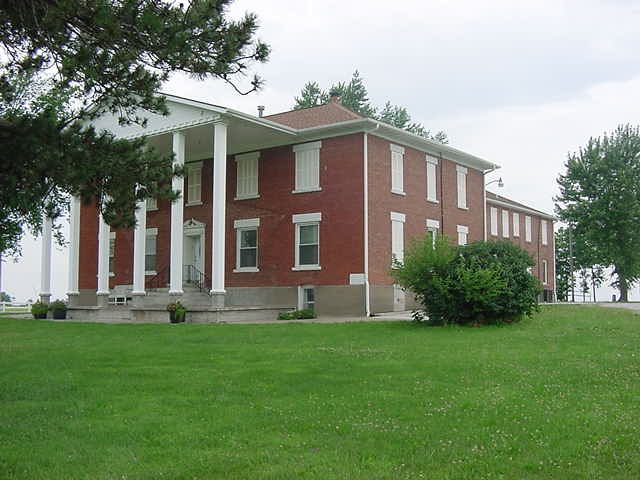
Stories and artifacts at the Bates County Museum depict the remarkable history of Bates County, from the Osage and early settlers, to the Battle of Island Mound and Orders No. 11, on through the prosperous Victorian age, finishing with Minuteman Missiles dotting the landscape in the early 20th century.
Bates County Museum is located in a beautiful two-story, red brick building, built in 1915, that was originally the County Poor Farm. Sitting on the northwest edge of Butler, Missouri, the Museum is home to an incredible collection of artifacts and extraordinary exhibits. The stories of local history seem to come alive when visitors meander through the rooms and hallways.
Bates County Museum is located in a beautiful two-story, red brick building, built in 1915, that was originally the County Poor Farm. Sitting on the northwest edge of Butler, Missouri, the Museum is home to an incredible collection of artifacts and extraordinary exhibits. The stories of local history seem to come alive when visitors meander through the rooms and hallways.
A warm welcome by the staff and an invitation to linger and learn makes a visit to the Bates County Museum both memorable and enjoyable. Discover local Osage Indian and pioneer history.
Learn about the Border War and Civil War including the Battle of Island Mound and Orders No. 11.
Other exhibits cover coal mining, railroads, early electricity and communications, the Victorian Age, Veterans and their wars—including the Cold War—and Bates County's Minuteman Missiles.
WEBSITELearn about the Border War and Civil War including the Battle of Island Mound and Orders No. 11.
Other exhibits cover coal mining, railroads, early electricity and communications, the Victorian Age, Veterans and their wars—including the Cold War—and Bates County's Minuteman Missiles.
Previous slide
Next slide
Battle of Carthage State Historic Site
1111 E Chestnut St. Carthage, MO
DIRECTIONS1111 E Chestnut St. Carthage, MO
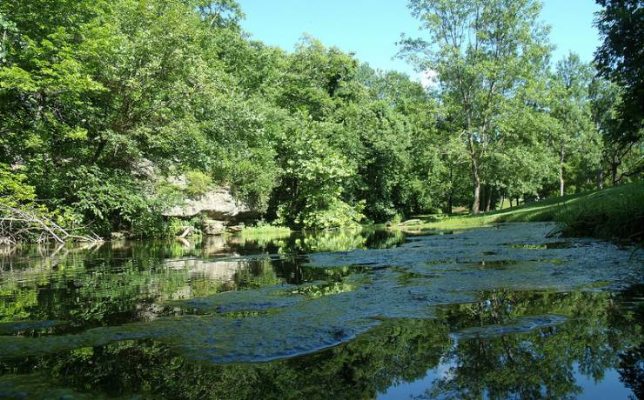
The Battle of Carthage was the earliest full-scale battle of the Civil War, preceding Bull Run by eleven days.
Battle of Carthage State Historic Site contains a quiet meadow and the spring that made the area an encampment for both the Union and Confederate troops during the battle. The area is little changed in its appearance since the battle was fought on July 5, 1861. A few minutes off of Interstate 44, the site interprets the battle that set the stage for a decisive showdown a month later at Wilson’s Creek.
Battle of Carthage State Historic Site contains a quiet meadow and the spring that made the area an encampment for both the Union and Confederate troops during the battle. The area is little changed in its appearance since the battle was fought on July 5, 1861. A few minutes off of Interstate 44, the site interprets the battle that set the stage for a decisive showdown a month later at Wilson’s Creek.
Battle of Carthage State Historic Site preserves only a small area associated with the battle, as skirmishes were spread over 10 miles. The historic site encompasses the Carter Spring area, which remains with little change from its 1861 condition and appearance. An interpretive kiosk explains the events of that hot summer day in July 1861. Group tours are given upon request through Nathan Boone Homestead State Historic Site.
Though this site is outside of the borders of Freedom's Frontier National Heritage Area, its stories connect with heritage area themes and stories.
WEBSITEThough this site is outside of the borders of Freedom's Frontier National Heritage Area, its stories connect with heritage area themes and stories.
Because Kansas saw the first armed conflict over slavery, and because John Brown identified the Battle of Black Jack as the first such battle in Kansas, many consider it to be the first battle of the American Civil War. The battlefield is now a National Historic Landmark.
In addition to the site of the Battle of Black Jack, the Black Jack Battlefield and Nature Park includes the historic Robert Hall Pearson House and Farmstead. Pearson fought alongside of John Brown toward the end of the battle, eventually purchasing the land and building his house overlooking the Battlefield in 1890. His descendants lived in the house until the property was purchased by the Trust in 2003.
The Park also contains the Black Jack Nature Trail and prairie restoration area, and is adjacent to the Ivan Boyd Prairie Preserve.
Self-Guided Tour brochures available in front of the Robert Hall Pearson Farmhouse. Pearson Farmhouse is open seasonally or by appointment.
WEBSITESelf-Guided Tour brochures available in front of the Robert Hall Pearson Farmhouse. Pearson Farmhouse is open seasonally or by appointment.
Previous slide
Next slide
Battle Of Island Mound State Historic Site
NW County Road1002, Butler, MO
DIRECTIONSNW County Road1002, Butler, MO

Visit the site of the first engagement of African American troops during the Civil War. Take a short walk on the trail and learn about the regiment that made U.S. history.
The Battle of Island Mound marked the first time that African-American troops were engaged in Civil War combat, nearly a year before the battle depicted in the film Glory. Battle of Island Mound State Historic site encompasses Fort Africa, where the 1st Kansas Colored Volunteer Infantry were camped in 1862 before a pitched battle with pro-Confederate forces near a low hill named Island Mound.
Walk the interpretive trail loop and learn about this battle as well as the effect that the 1st Kansas Colored Volunteer Infantry has on later Union decisions to allow African-American units to fight. A memorial monument and interpretive kiosk explain the battle and a .6 mile long trail includes interpretive panels; there is also a picnic shelter, picnic pads, vault toilets, water faucets and taps.
WEBSITEWalk the interpretive trail loop and learn about this battle as well as the effect that the 1st Kansas Colored Volunteer Infantry has on later Union decisions to allow African-American units to fight. A memorial monument and interpretive kiosk explain the battle and a .6 mile long trail includes interpretive panels; there is also a picnic shelter, picnic pads, vault toilets, water faucets and taps.
Previous slide
Next slide
Battle of Westport Visitor Center
4000 Baltimore Ave. Kansas City, MO
DIRECTIONS4000 Baltimore Ave. Kansas City, MO

Learn about the largest Civil War battle west of the Mississippi when you tour the Battle of Westport Visitor Center at Swope Park in Kansas City, Missouri.
The Battle of Westport, fought October 21-23, 1864, was the last full-scale action of the Civil War in Missouri and west of the Mississippi. This major battle, the largest engagement west of the Mississippi River, marked the climactic end of a decade of war and turbulence along the Missouri and Kansas border.
The Battle of Westport, fought October 21-23, 1864, was the last full-scale action of the Civil War in Missouri and west of the Mississippi. This major battle, the largest engagement west of the Mississippi River, marked the climactic end of a decade of war and turbulence along the Missouri and Kansas border.
Includes a driving tour of the Battle of Westport and a walking tour of the Big Blue Battlefield.
The best time to visit is on a Saturday because that is the day when the strongest interpreters are volunteering.
The main phone number for this site is also Dan Smith's law office, so be sure to state your interest in information regarding the Battle of Westport Visitor Center.
Other attractions at Swope Park include the Kansas City Zoo, Starlight Theatre, and Lakeside Nature Center.
WEBSITEThe best time to visit is on a Saturday because that is the day when the strongest interpreters are volunteering.
The main phone number for this site is also Dan Smith's law office, so be sure to state your interest in information regarding the Battle of Westport Visitor Center.
Other attractions at Swope Park include the Kansas City Zoo, Starlight Theatre, and Lakeside Nature Center.
Previous slide
Next slide
Baxter Springs Heritage Center & Museum
740 East Ave #740, Baxter Springs, KS
DIRECTIONS740 East Ave #740, Baxter Springs, KS

The Baxter Springs Heritage Center & Museum, operated by Baxter Springs Historical Society, is dedicated to preserving and interpreting the rich regional history of Baxter Springs, Kansas.
The museum is filled with exhibits depicting various stages of the city's history. Learn about Osage Indians, an attack on the city's Fort Blair in 1863 by William Clarke Quantrill, and how the city responded to the Civil War.
The museum is filled with exhibits depicting various stages of the city's history. Learn about Osage Indians, an attack on the city's Fort Blair in 1863 by William Clarke Quantrill, and how the city responded to the Civil War.
Explore exhibits about the lead and zinc mining era, including information and artifacts from the mining town of Picher, Oklahoma, closed in 2009 by the EPA as an unlivable town.
Enjoy twenty thousand square feet of climate-controlled historical exhibits for your pleasure.
WEBSITEEnjoy twenty thousand square feet of climate-controlled historical exhibits for your pleasure.
Previous slide
Next slide
Bingham-Waggoner Estate
Bingham-Waggoner Home, 313 W Pacific Ave. Independence, MO
DIRECTIONSBingham-Waggoner Home, 313 W Pacific Ave. Independence, MO

The Bingham-Waggoner Estate, once the home of artist George Caleb Bingham, is truly a one-of-a-kind gem. It's located near the historic downtown of Independence, Missouri.
Although the Truman Presidential Library and Harry and Bess Truman's home are popular sites, the Bingham-Waggoner Estate offers its own special look into an earlier era. This well-preserved estate provides insights into the lifestyles of the 19th century wealthy residents.
The house is also completely decorated for Christmas, and is open for the Christmas season from the day after Thanksgiving until Dec. 30 (closed Dec. 23-25).
WEBSITEThe house is also completely decorated for Christmas, and is open for the Christmas season from the day after Thanksgiving until Dec. 30 (closed Dec. 23-25).
Previous slide
Next slide
Burnt District Monument and Sharp-Hopper Log Cabin
400 E Mechanic St. Harrisonville, MO
DIRECTIONS400 E Mechanic St. Harrisonville, MO
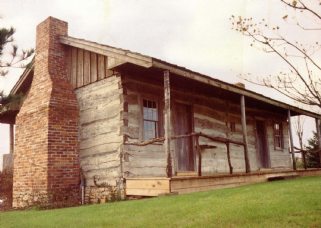
The Cass County Historical Society invites you to stop by and tour the Sharp-Hopper Cabin (open by appointment only) to learn more about the settlement of Cass County in the 1830s. The Burnt District Museum, located inside the Cass County Historical Society office, is also available to tour during operating hours. Special displays are available for viewing around the mezzanine outside of the office. Both areas offer an inside look at life in Cass County during the Civil War and beyond. The Cass County Historical Society also houses the archives dating back to the founding of the county.
The Margaret Wade Archives are open for academic and family research by appointment only.
WEBSITE
Previous slide
Next slide
Bushwhacker Museum
212 W Walnut St #2341, Nevada, MO
DIRECTIONS212 W Walnut St #2341, Nevada, MO
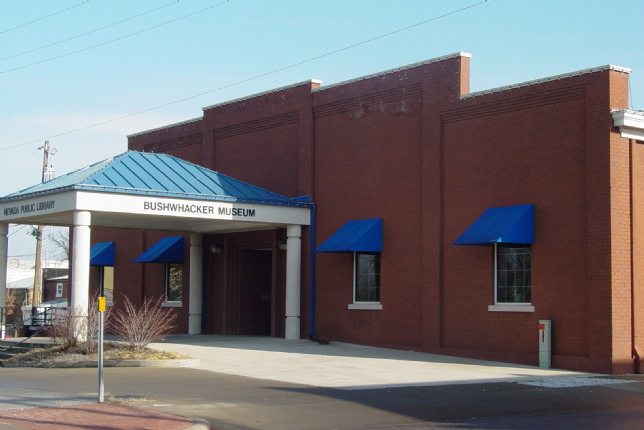
The Bushwhacker Museum opened in 1965 in the former Vernon County Jail and Sheriff’s home on North Main Street, a building once described as a “dungeon of medieval malevolence”. The jail had such a bad reputation prior to its closing in 1960, that some prisoners supposedly preferred to spend time at the Missouri State Penitentiary in Jefferson City. The name of the museum hearkens back to the Civil War days when the town of Nevada City was nick-named the “Bushwhacker Capital”. The museum was named after the much feared and often colorful pro-Southern guerrilla fighters known as “Bushwhackers”.
In 1997, the Bushwhacker Museum moved to the renovated Moss Building where it quickly grew to include exhibits on Osage Indians, Cottey College, railroads, State Mental Hospital #3, county schools, agriculture, and local medicine.
As a comprehensive regional history museum and genealogical research center, the Bushwhacker Museum serves the local community as a gathering place and a prominent attraction for tourists eager to learn more about the history of the Civil War in Missouri.
WEBSITEAs a comprehensive regional history museum and genealogical research center, the Bushwhacker Museum serves the local community as a gathering place and a prominent attraction for tourists eager to learn more about the history of the Civil War in Missouri.
Previous slide
Next slide
Fort Osage National Historic Landmark
107 Osage St. Sibley, MO
DIRECTIONS107 Osage St. Sibley, MO

Experience the western-most United States military post at the time of its founding in 1808. Walk in the footsteps of William Clark, Captain Eli Clemson, George and Mary Sibley, Sacagawea and Daniel Boone as you walk Fort Osage's historic grounds and view the Missouri River.
Reconstructed on its original site, Fort Osage (1808-1827) is a complex of hewn log structures located on a high bluff overlooking the Missouri River. Living history interpretation is featured year round, as staff and volunteers portray the work and livelihood of Fort Osage area soldiers, traders and residents. The historic Sibley cemetery, adjacent to the Fort grounds, can be accessed during your visit as well. The Santa Fe Trail can be found within a few minutes drive of the Fort.
The Fort Osage Education Center features exhibitions on the history of the Hopewell Culture, the Osage Indian Nation, Fort Osage's era of operation and the current Missouri River watershed. Access to the Missouri River is available through a hiking path from the Fort. The gift store carries a wide selection of books and merchandise related to the Fort and surrounding region.
WEBSITE
Previous slide
Next slide
Fort Scott National Historic Site
199 Old Fort Blvd. Fort Scott, KS
DIRECTIONS199 Old Fort Blvd. Fort Scott, KS

Explore this restored frontier fort and its role in westward expansion, Bleeding Kansas and the Civil War.
Promises made and broken! A town attacked at dawn! Thousands made homeless by war! Soldiers fighting settlers! Each of these stories is a link in the chain of events that encircled Fort Scott from 1842-1873. All of the site's structures, its parade ground, and its tallgrass prairie bear witness to this era when the country was forged from a young republic into a united transcontinental nation.
The story of Fort Scott is the story of America growing up. When the fort was established in 1842, the nation was still young and confined largely to the area east of the Mississippi River. Yet within a few years, Fort Scott's soldiers became involved in events that would lead to tremendous spurts of growth and expansion. As the nation developed, tensions over slavery led to the conflict and turmoil of "Bleeding Kansas" and the Civil War. Fort Scott takes you through these years of crisis and beyond to the time when the United States emerged as a united, transcontinental nation.
WEBSITE
Previous slide
Next slide
Harry S Truman Birthplace State Historic Site
1009 Truman St. Lamar, MO
DIRECTIONS1009 Truman St. Lamar, MO
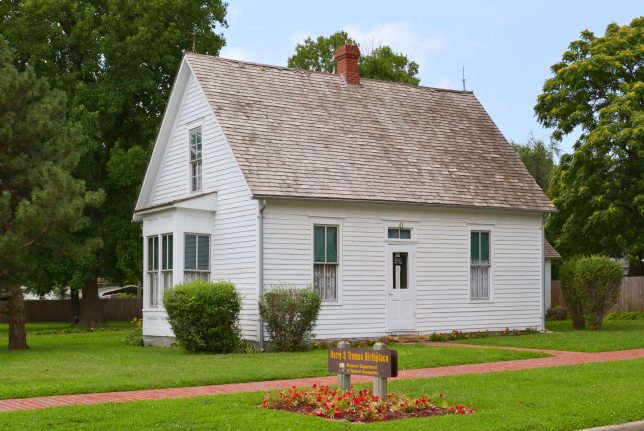
See the first home of the only U.S. president born in Missouri at Harry S Truman Birthplace State Historic Site. Visitors can view the small frame house where the future president was born, and see furnishings that reflect what a house in western Missouri would have looked like during the time Truman lived in the house.
Free tours are offered during office hours.
WEBSITEFree tours are offered during office hours.
Previous slide
Next slide
Harry S Truman Library and Museum
500 W US Hwy 24, Independence, MO
DIRECTIONS500 W US Hwy 24, Independence, MO

The Harry S. Truman Presidential Library & Museum was established to preserve the papers, books, and other historical materials relating to former President Harry S. Truman and to make them available to the people in a place suitable for exhibit and research. Consistently ranked among the top tourism destinations in the Kansas City region, no visit to America's heartland is complete without a trip to the Harry S. Truman Library & Museum.
WEBSITE
Previous slide
Next slide
Truman Home - Harry S Truman National Historic Site
223 N Main St. Independence, MO
DIRECTIONS223 N Main St. Independence, MO
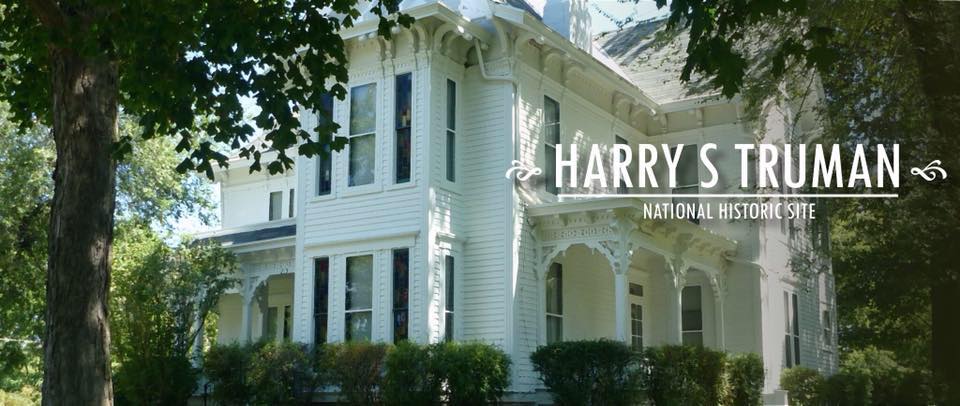
"I hope to be remembered as the people's President."
President Harry S Truman took America from its traditional isolationism into the age of international involvement. Despite his power, he never forgot where he came from. Today, visitors can experience the surroundings Truman knew as a young man of modest ambition through his political career and final years as a former president.
The home where Harry and Bess Truman returned to in 1953, after Harry left the White House, is available for tours. Sign up at the National Park Service site at 223 N. Main.
After your tour walk across Delaware Street to the Noland Home. This is where Harry’s cousins Nellie and Ethel Noland invited him to meet their neighbor Bess Wallace for the first time. Their freshly renovated home is a recent addition to the historic site, with a gallery that takes you deeper into the Trumans’ domestic life.
WEBSITEAfter your tour walk across Delaware Street to the Noland Home. This is where Harry’s cousins Nellie and Ethel Noland invited him to meet their neighbor Bess Wallace for the first time. Their freshly renovated home is a recent addition to the historic site, with a gallery that takes you deeper into the Trumans’ domestic life.
Previous slide
Next slide
John Brown Museum
1000 Main St. Osawatomie, KS
DIRECTIONS1000 Main St. Osawatomie, KS

Learn more about Brown, his supporters and the Battle of Osawatomie, Kansas.
Reverend Samuel Adair and his wife, Florella, came settled near Osawatomie, an abolitionist community and center of conflict during "Bleeding Kansas." The Adair cabin was a station on the Underground Railroad and Florella's half brother, John Brown, used this cabin as his headquarters. Learn more about the family and the border war when you visit the John Brown Museum. Operated in partnership with the City of Osawatomie.
WEBSITE
Previous slide
Next slide
Lee's Summit Historical Society
220 SW Main St. Lee's Summit, MO
DIRECTIONS220 SW Main St. Lee's Summit, MO

The Historical Society of Lee's Summit maintains a museum in the 1939 Post Office in downtown Lee's Summit on West Main Street.
The area now known as Lee's Summit began as a lush prairie inhabited by the Osage Indians. Tall grasses covered the area, and the only trees were located along the many streams that existed at the time.
In 1808, a treaty between the Osage Indians and the U.S. government was signed, and the Indians were eventually moved from their land to reservations.
The area now known as Lee's Summit began as a lush prairie inhabited by the Osage Indians. Tall grasses covered the area, and the only trees were located along the many streams that existed at the time.
In 1808, a treaty between the Osage Indians and the U.S. government was signed, and the Indians were eventually moved from their land to reservations.
The word spread quickly about the beauty of this area. Early settlers arrived between the years of 1830 and 1867.
The period that was perhaps the darkest in the history of Lee's Summit and the surrounding towns was the Border War which started in the mid 1850s. The Border War eventually escalated into the Civil War 1861. Most of the citizens of Big Cedar (Lee's Summit), Lone Jack, Raytown, Pleasant Hill, to name a few, were Southern Sympathizers. There were many bloody skirmishes during this time. The notorious William Quantrill and his band of guerrilla's, which included the three Younger brothers, rode the country side and reaped havoc on the Union forces.
The period that was perhaps the darkest in the history of Lee's Summit and the surrounding towns was the Border War which started in the mid 1850s. The Border War eventually escalated into the Civil War 1861. Most of the citizens of Big Cedar (Lee's Summit), Lone Jack, Raytown, Pleasant Hill, to name a few, were Southern Sympathizers. There were many bloody skirmishes during this time. The notorious William Quantrill and his band of guerrilla's, which included the three Younger brothers, rode the country side and reaped havoc on the Union forces.
In 1863 Quantrill burned Lawrence, Kansas, and killed many of its residents. In retaliation for this slaughter, Union General Thomas Ewing issued the infamous Orders No. Eleven. This order stated that all the residents of Jackson, Bates and other bordering counties must leave their homes and possessions within ten days or suffer the consequences. Families were forced to leave everything behind, including livestock, and above all, their homesteads. The settlers fled to friends' homes in unaffected areas; and some, who had the means, went back to their original family homes in the South.
Union troops burned and slaughtered their way through the counties listed in Orders No. 11. Many towns were totally destroyed, lives were lost, and the face of the area was changed forever. The scars of Orders No. 11 remain with us today.
The museum contains an exhibit on the Border War including Lee's Summit's notorious resident Cole Younger, maps, photographs, and artifacts of early Lee's Summit. Displays include a re-creation of the Vogue Theater, a WPA kitchen, information on local musical families the Brownings and Methenys. Much more can be found at the museum including a gift shop and research room.
WEBSITEThe museum contains an exhibit on the Border War including Lee's Summit's notorious resident Cole Younger, maps, photographs, and artifacts of early Lee's Summit. Displays include a re-creation of the Vogue Theater, a WPA kitchen, information on local musical families the Brownings and Methenys. Much more can be found at the museum including a gift shop and research room.
Previous slide
Next slide
Linn County Historical Museum
307 Park St. Pleasanton, KS
DIRECTIONS307 Park St. Pleasanton, KS

Exhibits tell the story of Native Americans, early explorers and the Linn County, Kansas, role in the Missouri-Kansas Border War.
Take a tour through the Linn County Museum and view some of the earliest history in Kansas. You will learn about the Indians who inhabited the area; explorers; French traders and trappers; and the first lead mine in the state of Kansas. You’ll also learn about the Sugar Creek Mission, the Trail of Death, and the Potawatomie Indians.
Take a tour through the Linn County Museum and view some of the earliest history in Kansas. You will learn about the Indians who inhabited the area; explorers; French traders and trappers; and the first lead mine in the state of Kansas. You’ll also learn about the Sugar Creek Mission, the Trail of Death, and the Potawatomie Indians.
Take a stroll back to the years of the Border Wars and learn about the Bushwhackers. Learn of the tragic story of the Marais des Cygnes Massacre; and the fight to have a Free State during the days of Bleeding Kansas. In the museum you will learn about the Battle of Mine Creek through displays and maps that depict the battle.
Linn County Museum has a comprehensive and extensive collection of memorabilia documenting Pleasanton, Kasnas. A walk through the museum will give you an opportunity to appreciate the rich history of the community's founding families. With authentic items from such organizations as The Independent Order of Odd Fellows, a bank front, toys and cars, there is a piece of history each member of the family will find captivating.
WEBSITELinn County Museum has a comprehensive and extensive collection of memorabilia documenting Pleasanton, Kasnas. A walk through the museum will give you an opportunity to appreciate the rich history of the community's founding families. With authentic items from such organizations as The Independent Order of Odd Fellows, a bank front, toys and cars, there is a piece of history each member of the family will find captivating.
Previous slide
Next slide
Mahaffie Stagecoach Stop-Farm
1200 E Kansas City Rd. Olathe, KS
DIRECTIONS1200 E Kansas City Rd. Olathe, KS

Mahaffie Historic Site is the only remaining stagecoach stop on the Santa Fe Trail preserved for the public. We are open year-round. Activities and admission fees vary with the seasons and special events. Enjoy 1860s living history activities, including stagecoach rides, each Spring and Fall weekend, and Wednesday-Sunday, between Memorial Day and Labor Day.
WEBSITE
Previous slide
Next slide
Marais des Cygnes Massacre State Historic Site
26426 E 1700th Rd. Pleasanton, KS
DIRECTIONS26426 E 1700th Rd. Pleasanton, KS

Visit the Marais des Cygnes Massacre State Historic Site near Pleasanton, Kansas, where, in 1858, proslavery men shot 11 free-state men.
On May 19, 1858, proslavery men killed five free-state men and wounded five others in a ravine that is now listed as a National Historic Landmark. The massacre, which followed earlier guerrilla warfare activities, on both sides, shocked the nation and became a pivotal event in the "Bleeding Kansas" era. A few months later, abolitionist John Brown came to the site and constructed a fortified cabin. Walk the grounds of this sites and learn more about the tensions during the era of territorial Kansas. There are interpretive signs that tell the story of the massacre, and there is an audio station (hand-crank device) where you can listen to narration.
This site is in a rural setting. You will have to travel gravel roads to get to it. In inclement weather, road conditions may not be ideal to visit the site. If you would like more information, contact nearby Mine Creek Battlefield State Historic Site, which oversees Marais des Cygnes Massacre State Historic Site, at 913-352-8890.
WEBSITE
Previous slide
Next slide
Miami County Historical Museum
12 E Peoria St. Paola, KS
DIRECTIONS12 E Peoria St. Paola, KS

The Miami County Historical Museum, in Paola, Kansas, was named as one of ten Civil War Treasures of the Kansas and Missouri area by the Kansas City Star newspaper.
The museum also has an extensive Native American exhibit, with complete arrow heads dating back to 10,000 B.c., as well as pottery shards dating 6,500 B.C., all found in Miami County.
The museum also has an extensive Native American exhibit, with complete arrow heads dating back to 10,000 B.c., as well as pottery shards dating 6,500 B.C., all found in Miami County.
The museum is home to the history of John Brown and William Quantrill. John Brown settled in Osawatomie while Quantrill initially settled in Paola as a school teacher, before turning guerrilla. There are artifacts, including photos, weapons and even an amputation kit from this period. The building the museum is in was once a turn of the century coffin shop, and the museum has a collection of wicker coffins.
WEBSITE
Previous slide
Next slide
Mine Creek Civil War Battlefield State Historic Site
20485 KS-52, Pleasanton, KS
DIRECTIONS20485 KS-52, Pleasanton, KS
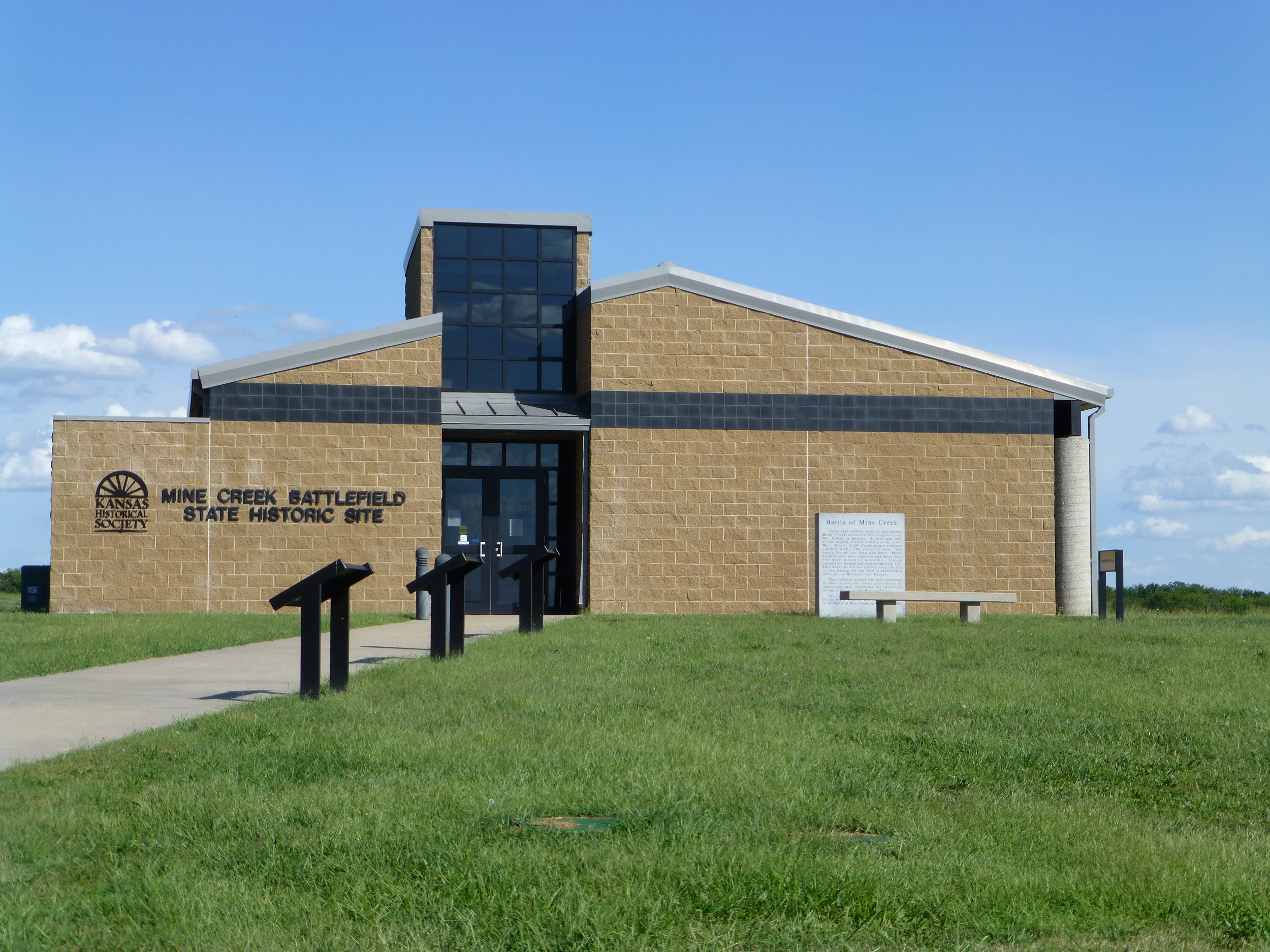
Walk the battlefield that is among the largest cavalry engagements of the Civil War.
On October 25, 1864, on the banks of Mine Creek, two Union brigades of approximately 2,500 troops defeated approximately 7,000 Confederates from General Sterling Price's Army of Missouri. Federal Colonels Frederick W. Benteen and John H. Philips led the attack in one of the largest cavalry battles of the Civil War and a major battle fought in Kansas. Their dramatic story comes alive at Mine Creek Battlefield.
Horses, bikes, ATVs and motorbikes are not permitted on the battle grounds of Mine Creek Civil War Battlefield State Historic Park. Leashed dogs are welcome on the grounds and trails.
After your tour walk across Delaware Street to the Noland Home. This is where Harry’s cousins Nellie and Ethel Noland invited him to meet their neighbor Bess Wallace for the first time. Their freshly renovated home is a recent addition to the historic site, with a gallery that takes you deeper into the Trumans’ domestic life.
WEBSITEHorses, bikes, ATVs and motorbikes are not permitted on the battle grounds of Mine Creek Civil War Battlefield State Historic Park. Leashed dogs are welcome on the grounds and trails.
After your tour walk across Delaware Street to the Noland Home. This is where Harry’s cousins Nellie and Ethel Noland invited him to meet their neighbor Bess Wallace for the first time. Their freshly renovated home is a recent addition to the historic site, with a gallery that takes you deeper into the Trumans’ domestic life.
Previous slide
Next slide
Monticello Community Historical Society
23860 W 83rd St. Shawnee, KS
DIRECTIONS23860 W 83rd St. Shawnee, KS
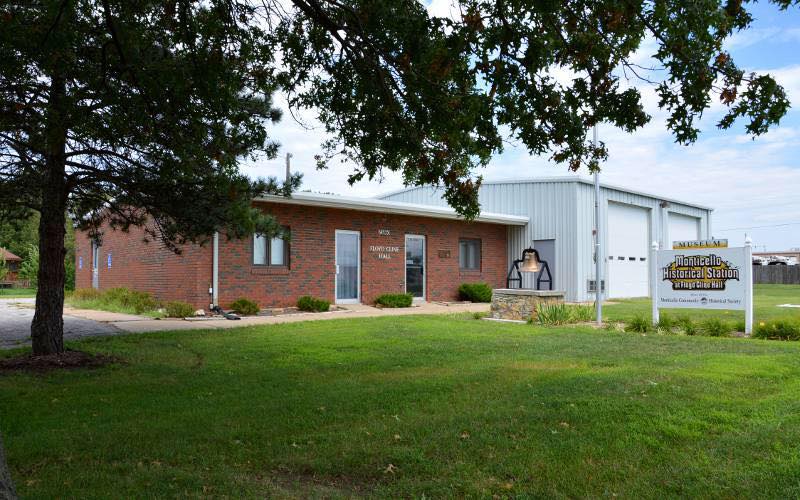
The Monticello Community Historical Society, in Lenexa, Kansas, is dedicated to the appreciation, preservation and celebration of the history and heritage of the Monticello Community, Johnson County, Kansas.
President Harry S Truman took America from its traditional isolationism into the age of international involvement. Despite his power, he never forgot where he came from. Today, visitors can experience the surroundings Truman knew as a young man of modest ambition through his political career and final years as a former president.
Home to the Shawnee, Chouteau, and Wild Bill, Monticello was a river crossing point that connected with historic overland wagon trails and inter-regional transportation routes.
Take the Monticello Historical Driving/Biking Tour. Brochure at the Monticello Historical Station.
WEBSITETake the Monticello Historical Driving/Biking Tour. Brochure at the Monticello Historical Station.
Previous slide
Next slide
National Frontier Trails Museum
416 W Maple Ave. Independence, MO
DIRECTIONS416 W Maple Ave. Independence, MO

Follow the nation’s expansion along the Santa Fe, Oregon and California Trails at the National Frontier Trails Museum in Independence, Missouri.
The museum tells the story of the exploration, acquisition, and settlement of the American West. An award-winning introductory film prepares visitors for the interpretive exhibits which guide them along the Santa Fe, Oregon, and California Trails. Quotations from trail diaries are extensively used, allowing pioneer travelers to tell of their experiences in their own words.
The museum tells the story of the exploration, acquisition, and settlement of the American West. An award-winning introductory film prepares visitors for the interpretive exhibits which guide them along the Santa Fe, Oregon, and California Trails. Quotations from trail diaries are extensively used, allowing pioneer travelers to tell of their experiences in their own words.
National Frontier Trails Museum is the nation's only historic site certified for five National Historic Trails connected to the westward expansion of the U.S.: Santa Fe, Oregon, California, Mormon, and Lewis and Clark.
WEBSITE
Previous slide
Next slide
Osage Village State Historic Site
Farm road 2300, Walker, MO
DIRECTIONSFarm road 2300, Walker, MO

Today, a walking trail and outdoor exhibits help visitors to imagine the daily activities at this once-thriving Indian village.
Various interpretive stops along the trail allow visitors to visualize the relationship of this site to other nearby Osage and early European sites that once existed on distant hillsides. The quiet and peaceful hilltop scenery at Osage Village State Historic Site only hints at the presence of a village that once housed between 2,000 and 3,000 people living in about 200 lodges. The site features a walking trail and outdoor exhibits that help visitors visualize the village, which was inhabited between 1700 and 1775.
WEBSITE
Previous slide
Next slide
Prairie State Park
128 NW 150th Ln. Mindenmines, MO
DIRECTIONS128 NW 150th Ln. Mindenmines, MO

Tallgrass prairies once covered more than a third of Missouri; today, less than one percent remains, much of it preserved at Prairie State Park. Visitors to the park see panoramic vistas of swaying grass and ever-changing wildflowers. They also may spot an elk or the park’s resident bison herd.
During any season, visitors can experience prairie life by hiking one of the park’s trails. Visitors can take a short hike or reserve the park’s backpacking camp and sleep under the vast prairie sky. With more than 150 bird species, some of which are rare and endangered, bird watching is a favorite activity. The trails also provide a great place for nature study, photography, and viewing wildflowers and wildlife. The park also has a picnic area and limited camping. Potable water is available on the south side of the shop building before you enter the camping and picnicking area.
The park’s Regal Tallgrass Prairie Nature Center features exhibits that interpret the tallgrass prairie, such as a diorama depicting the prairie from spring to fall, a bison exhibit and interactive activities. Park naturalists conduct programs that interpret prairie life and stress the importance of preserving this rare and sweeping historic landscape.
WEBSITE
Previous slide
Next slide
Shawnee Indian Mission State Historic Site
3403 W 53rd St. Fairway, KS
DIRECTIONS3403 W 53rd St. Fairway, KS

This state historic site in Fairway, Kansas, was established in 1839 as a Methodist Manual Training School. Children from 23 tribes attended the school before the site became a Union Soldiers encampment during the Civil War.
Shawnee Mission, like many other missions, was established as a manual training school attended by boys and girls from Shawnee, Delaware, and other Indian nations from 1839 to 1866. Visit this 12-acre National Historic Landmark and learn the stories of those who lived there.
WEBSITE
Previous slide
Next slide
St. Clair County Museum and Historical Society
660 Main St. Osceola, MO
DIRECTIONS660 Main St. Osceola, MO

Located in an historic church building in Osceola, Missouri, this museum has displays on the main floor and ground floor featuring artifacts of St. Clair County's past.
WEBSITE
Previous slide
Next slide
Trading Post Museum
15710 N 4th St. Pleasanton, KS
DIRECTIONS15710 N 4th St. Pleasanton, KS

Learn about the oldest, still-occupied settlement in Kansas. Trading Post was established prior to 1825 as a trade center.
Learn about the oldest, still-occupied settlement in Kansas. Trading Post was established prior to 1825 as a trade center.
Along with the main building, you can tour the 1886 schoolhouse, the Amos Tubbs cabin, and a machine shop. The museum houses Linn County tax ledger books from 1863 forward, census records, Trading Post school records, obituaries, marriage records for Linn County, cemetery records, as well as many photographs of area residents.
Along with the main building, you can tour the 1886 schoolhouse, the Amos Tubbs cabin, and a machine shop. The museum houses Linn County tax ledger books from 1863 forward, census records, Trading Post school records, obituaries, marriage records for Linn County, cemetery records, as well as many photographs of area residents.
The Museum also houses a large genealogy library and resources. Open regular hours and by appointment.
WEBSITE
Previous slide
Next slide
Union Cemetery
227 E 28 Terr. Kansas City, MO
DIRECTIONS227 E 28 Terr. Kansas City, MO

Burial ground for many notable pioneer founders and leaders of Westport and Kansas City.
Founded in 1857, Union Cemetery is the oldest public cemetery in Kansas City, MO, and is the final resting place of over 55,000 souls. Listed on the National Register of Historic Places, the land was originally claimed and plotted out to be the cemetery for both the town of Westport and the town of Kansas (now Kansas City). Many famous and historically significant individuals are buried in the Cemetery, without whom, Kansas City would not be what it is today. Veterans from every war from the Revolutionary War to the Vietnam War are also buried here, including those who fought for both sides during the Civil War. The Cemetery maintains a strong military identity, honoring those who served our country.
Founded in 1857, Union Cemetery is the oldest public cemetery in Kansas City, MO, and is the final resting place of over 55,000 souls. Listed on the National Register of Historic Places, the land was originally claimed and plotted out to be the cemetery for both the town of Westport and the town of Kansas (now Kansas City). Many famous and historically significant individuals are buried in the Cemetery, without whom, Kansas City would not be what it is today. Veterans from every war from the Revolutionary War to the Vietnam War are also buried here, including those who fought for both sides during the Civil War. The Cemetery maintains a strong military identity, honoring those who served our country.
Today, Union Cemetery is located just south of Crown Center and east of the Liberty Memorial, and is open to the public, maintained by both the Kansas City Parks Department and the Union Cemetery Historical Society.
WEBSITE
Previous slide
Next slide